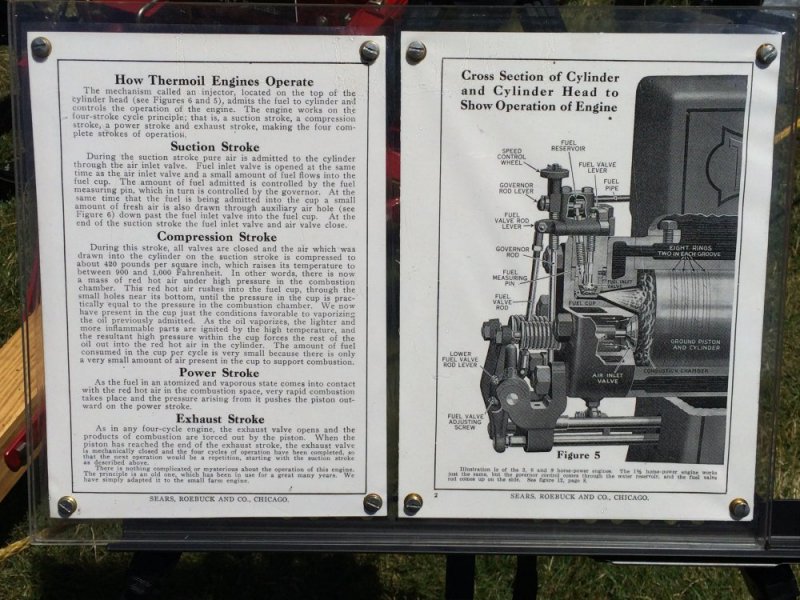n8in8or
I never met a project I didn’t like
I attended the local tractor show this afternoon and stumbled on a pretty cool engine. It was a little stationary diesel engine built in 1920! The owner had some literature for the engine on display and I took a picture of it.

I thought it was pretty cool how familiar the combustion chamber looked even 96 years ago. One main difference was that the fuel wasn't injected in. I spoke to the owner for quite a few minutes and he was also the one that restored the engine. He told me that rather than injection, a valve opened when the piston was on the downstroke and it would allow the fuel to be drawn in, then it would close to build pressure on the chamber which of course causes combustion. He said it can be quite finicky to start, especially when cold. When it is being cranky, he has a Honda 5hp gas engine mounted on a hand-held rig to turn the engine over instead of cranking it over by hand. I got to watch him restart the engine because he had to shut it down for regreasing (which he does every 1.5 hours). It actually didn't start too badly for being turned over by hand, but it hadn't cooled off too much in the time he repacked all the grease cups (maybe 5 minutes or a little more?). Another interesting thing about the engine is that of course it was marketed to run on just about any fuel but gasoline, but in order to do so you had to adjust the compression ratio......yes, the compression ratio! You did this by adding or removing shims in the 3 piece connecting rod! I wish I had taken a picture of the rod to illustrate this. He said the factory shipped the engine with a .012" shim and taking that out alone made a big difference depending on the fuel and conditions. It also affected timing as well. It was so cool talking to such a knowledgable man regarding such a unique engine.
Here's a quick video of it running. Enjoy.

I thought it was pretty cool how familiar the combustion chamber looked even 96 years ago. One main difference was that the fuel wasn't injected in. I spoke to the owner for quite a few minutes and he was also the one that restored the engine. He told me that rather than injection, a valve opened when the piston was on the downstroke and it would allow the fuel to be drawn in, then it would close to build pressure on the chamber which of course causes combustion. He said it can be quite finicky to start, especially when cold. When it is being cranky, he has a Honda 5hp gas engine mounted on a hand-held rig to turn the engine over instead of cranking it over by hand. I got to watch him restart the engine because he had to shut it down for regreasing (which he does every 1.5 hours). It actually didn't start too badly for being turned over by hand, but it hadn't cooled off too much in the time he repacked all the grease cups (maybe 5 minutes or a little more?). Another interesting thing about the engine is that of course it was marketed to run on just about any fuel but gasoline, but in order to do so you had to adjust the compression ratio......yes, the compression ratio! You did this by adding or removing shims in the 3 piece connecting rod! I wish I had taken a picture of the rod to illustrate this. He said the factory shipped the engine with a .012" shim and taking that out alone made a big difference depending on the fuel and conditions. It also affected timing as well. It was so cool talking to such a knowledgable man regarding such a unique engine.
Here's a quick video of it running. Enjoy.
